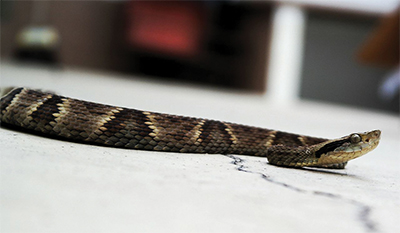MCP: Just drops of viper venom
pack a deadly punch
A bite from a lancehead viper can be fatal. Species in the family, among the most dangerous snakes in Central and South America, have venom that can disrupt blood clotting and cause hemorrhage, strokes and kidney failure.
Researchers at Brazil’s largest producer of anti-venoms have done a structural analysis of glycans modifying venom proteins in several species of lancehead. The report offers insight into the solubility and stability of toxic proteins from venom and into how venoms from different species vary. Scientists are working to map glycan structures back onto the proteins they modify.

Solange Serrano, a researcher at the Laboratory of Applied Toxicology at the Instituto Butantan in Sao Paulo, studies the protein toxins in lancehead venom. In a recent article in Molecular & Cellular Proteomics, scientists from Serrano’s laboratory, in collaboration with researchers at the University of New Hampshire, report on the sweet side of snake venom toxins.
The researchers looked at glycans, a group of sugar molecules attached in a complex chain, often with many branches, that can be attached to proteins. According to Serrano, most proteins in lancehead venom are modified with glycans, which can affect the proteins’ folding, stability and binding. But little is known about glycan structure in the venom.
Serrano’s graduate student Debora Andrade-Silva visited the laboratory of glycomics expert Vernon Reinhold in New Hampshire to learn techniques for structural characterization of glycans. While there, Andrade-Silva and colleagues characterized the structure of 60 glycan chains in eight lancehead, or Bothrops, species’ venoms. The researchers isolated the glycans and analyzed them by mass spectrometry, breaking down each complex molecule into smaller, simpler ions. By piecing together the spectra of many such ions, they could tell which sugars were present and how they were linked into treelike glycan structures.
Lancehead venom contains nearly 100 milligrams of protein per milliliter of liquid. At this concentration, protein solutions tend to become viscous or form gels. Analyzing the structures of glycans attached to the proteins, the researchers found that a disproportionate number were tipped with sialic acid, a sugar with a negative charge.
“Glycans containing sialic acid may help in venom solubility and increase toxin half-life,” Serrano said.
Sialic acid on a toxic enzyme may also bind to host proteins called siglecs, pulling the enzyme closer to target cells for greater effect; this has been observed in other types of venom.
While Serrano’s group researches venom composition, the applications are close to home. Another department of the Instituto Butantan produces most of the anti-venom available in Brazil. Serrano said she hopes that basic research into venom toxins will help researchers develop improved treatments for envenomation.
“The antivenoms do a reasonable job, but they are not so good at neutralizing the local effects of snakebite,” Serrano said.
These effects, including swelling, hemorrhage and necrosis, can be so severe that doctors must sometimes amputate bitten limbs. Better understanding of how venom differs between snake species could improve the efficacy of anti-venom treatment.
Andrade-Silva and Serrano are working to map the structures from the glycan inventory back onto the proteins they modify. Because some venom proteins have been repurposed as medicines, knowing more about how glycosylation helps each protein fold, hold its shape and attach to binding partners may have applications in biotechnology.
Enjoy reading ASBMB Today?
Become a member to receive the print edition four times a year and the digital edition monthly.
Learn moreGet the latest from ASBMB Today
Enter your email address, and we’ll send you a weekly email with recent articles, interviews and more.
Latest in Science
Science highlights or most popular articles

Exploring the link between lipids and longevity
Meng Wang will present her work on metabolism and aging at the ASBMB Annual Meeting, March 7-10, just outside of Washington, D.C.

Defining a ‘crucial gatekeeper’ of lipid metabolism
George Carman receives the Herbert Tabor Research Award at the ASBMB Annual Meeting, March 7–10, just outside of Washington, D.C.

The science of staying strong
Muscles power every movement, but they also tell the story of aging itself. Scientists are uncovering how strength fades, why some species resist it and what lifestyle and molecular clues could help preserve muscle health for life.

Bacteriophage protein could make queso fresco safer
Researchers characterized the structure and function of PlyP100, a bacteriophage protein that shows promise as a food-safe antimicrobial for preventing Listeria monocytogenes growth in fresh cheeses.

Building the blueprint to block HIV
Wesley Sundquist will present his work on the HIV capsid and revolutionary drug, Lenacapavir, at the ASBMB Annual Meeting, March 7–10, in Maryland.

Gut microbes hijack cancer pathway in high-fat diets
Researchers at the Feinstein Institutes for Medical Research found that a high-fat diet increases ammonia-producing bacteria in the gut microbiome of mice, which in turn disrupts TGF-β signaling and promotes colorectal cancer.

